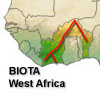 



Weather data
A large number of automatic weather stations has been implemented in the frame of the BIOTA AFRICA project by the Namibian National Botanical Research Institute (NBRI) and the Group "Biodiversity, Evolution and Ecology" (BEE) of the University of Hamburg. The website offers hourly updates of data and graphs of a large number of weather parameters.

|
 BIOTA West Africa - Workpackage - CT2-T1-WP1b
BIOTA West Africa - Workpackage - CT2-T1-WP1b
Core Topic (CT) |
Land use changes: agriculture and restoration |
Topic (T) |
Land use change related to cash crops |
Title |
 Impact of cash crop cultivation on biodiversity - Plant and animal diversity and cotton cultivation
Impact of cash crop cultivation on biodiversity - Plant and animal diversity and cotton cultivation
|
Project leader(s) |
Dr. Souleymane Konaté
Prof. Dr. Elisabeth Kalko & Jakob Fahr
Prof. Dr. Mark-Oliver Rödel
Prof. Dr. Brice Sinsin
|
Project description |
Cotton production has dramatically increased throughout the last few decades in West African countries and is, apart from logging, the major driver of habitat conversion in Benin. In this country the tripling of cotton production between 1993 and 2004 was mostly achieved by the extension of cultivated land.
Biodiversity changes of selected taxa (i.e. plants, soil arthropods, amphibians and bats) induced by cotton production are measured by a continued monitoring routine in the Biodiversity Observatories (BO). For this task, the established BOs are complemented by additional plots that are situated close to cotton fields. During the previous BIOTA phases the aim was to investigate differences in the diversity of our target groups between protected and altered savanna habitats. The next phase now aims at differentiating biodiversity levels between selected agroforestry systems, namely between areas under intense cotton production and Vitellaria parklands. Socio-economic data on these varying agro-ecological systems with a focus on intense cotton production will be provided by research from WP 2b and included in the analytical framework.
|
|
|






 Go to the WeatherNet
Go to the WeatherNet BIOTA West Africa - Workpackage - CT2-T1-WP1b
BIOTA West Africa - Workpackage - CT2-T1-WP1b Impact of cash crop cultivation on biodiversity - Plant and animal diversity and cotton cultivation
Impact of cash crop cultivation on biodiversity - Plant and animal diversity and cotton cultivation